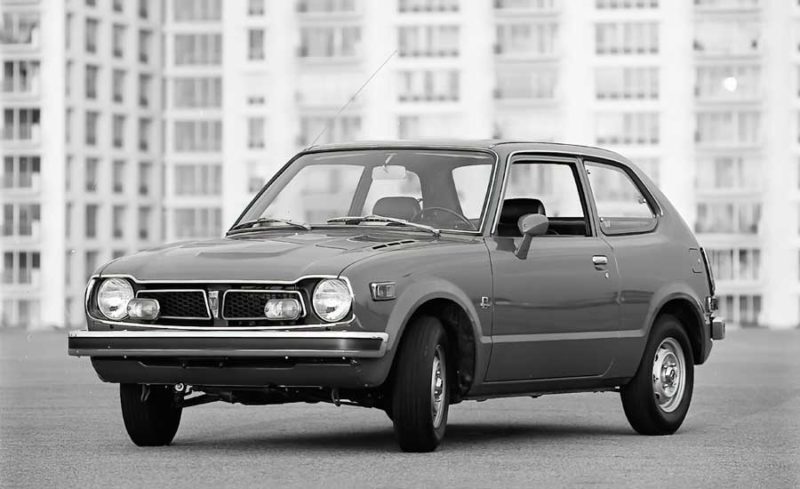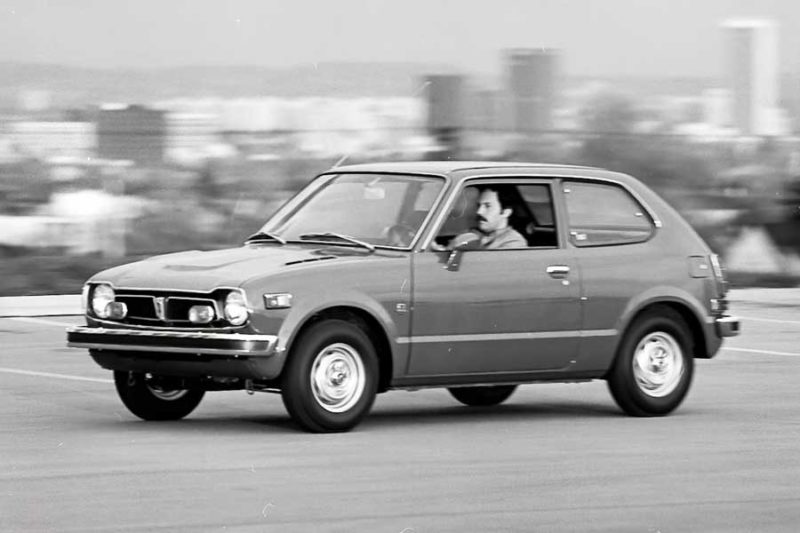In the first half of the 1970s, the Japanese automotive industry was on the rise in Europe. The established order on our continent became increasingly competitive. One of the Japanese manufacturers who responded to the European market potential of those years was Honda. After a modest start with the 600 and 800 types, the Japanese surprised with the front-wheel drive Honda Civic, a dynamic and compact response to the increasing traffic intensity.
The Honda Civic made its entrance on the market. Keywords: Compact, fully equipped, front disc brakes (on the home market there was also a version with drum brakes, disc brakes were reserved for the GL there), front-wheel drive, several body styles and the 1.170 cc engine with an overhead camshaft coupled to a four-speed gearbox that was able to to deliver excellent performance. Together with the independent wheel suspension all round and excellent fuel economy, these were factors for a successful introduction. The Honda Civic, which was initially available as a two- and three-door version, became a formidable competitor in Europe for the Renault 5, Peugeot 104, Fiat 127, Autobianchi A112 and the Datsun 100 A. The oil crisis of 1973 also put the Honda Civic no harm done. The demand for compact cars with efficient combustion engines increased due to the oil shortage.
Extension
Speaking of 1973: from that year on, Honda also offered the option of equipping the Civic with the Hondamatic two-speed automatic transmission. And in 1974 the program was expanded with a five-door combination car and the four-door version. Both body styles were longer in size than the two- and three-door versions. Furthermore, the Japanese added the 1.488 cc engine to the delivery range. It was installed in the four-door version and the station wagon. From 1974, buyers could also choose to have a five-speed gearbox fitted in the Honda Civic. This 1169 cc engine was soon replaced by a power source with a displacement of 1.237 cc. The overhead camshaft was maintained.
Special models for Japan and America
Honda also built special versions. One of these was the Honda Civic 1200 RS, a sports version for the Japanese home market with a modified 1.169 cc engine and two carburettors. The CVCC engine was also developed for the American and Japanese market, a power source that ultimately emitted fewer harmful substances thanks to a pre-combustion of rich mixture. The carburettor and cylinder head were designed in such a way that the mixture entered the power unit in two phases, resulting in a more favorable consumption. This engine came in October 1975 in a modified form (and a power of 75 hp) also 1500 RSL/GTL. This succeeded the 1200 RS within the JDM (the Japanese home market).
Facelift
In 1977 the Honda Civic was facelifted. The bumper sections at the front and rear were changed to accommodate various forms of lighting. The four-door version was discontinued during the model change (for Europe), the five-door hatchback was an extension of the range. Honda also said goodbye to the Civic, where it all started: the two-door version. Meanwhile, the CVCC engines were also modified. From September 1977 until the end of production of the first generation of the Honda Civic, this efficient engine was available with displacements of 1.238 cc and 1.488 cc.
Automobile breakthrough for Honda in Europe
Regardless, the first Honda Civic was a success and is widely regarded as Honda's automotive breakthrough in Europe. And anyone who has ever driven such a lidded Honda Civic knows why the Honda Civic was a success. He paved the way for the next generations and other Hondas. The first generation Honda Civic was succeeded in 1979 by generation number two.





Oh yes, “Haags-Moerwijk” youth sentiment those capricious Japanese. The first Datun 100 A, the best Corolla. An Italian neighbor had a burgundy Civic sedan, chic box with that thick upholstery. I wasn't used to that at all from my old man's VWs.
How cleverly did the Japanese at the time make their way into the "car cradle" of the world, by the way.
If I remember correctly, the first Japanese rusted terribly because they were practically unprotected on ship decks for weeks, months during their journey to Europe.
My parents bought a 70nd generation Civic in the late 2s. It was not my choice, but the car drove quite fine.
We had a Civic Wagon in the early 80s. Great little car with a super engine. But rust!! Our cat once jumped on the engine cover and fell through it.....
I had one briefly as a vintage car, got rid of it because I didn't have the time to properly tackle the leaking head gasket. What is written below I can only agree, drove (yes, plenty done in that short time) at a certain point rather than with my "normal" family car, a 98′ Civic 1.8VTI (MB6, British manufacture) . Not for pleasure rides, but for everyday use. That way you can often start conversations.
What I could remember as a peculiarity of that car was the bag of windshield washer fluid, rather than the tank I was used to. Still not leaking after 30(+) years. And the power brakes that were on the right side, where the brake pedal is on right-hand drive versions. From the left, an axle ran to the right behind the engine to activate the power brakes. You would think it hadn't been thought through that that car was developed as a right-hand drive and that a left-hand drive version had to be developed hastily. But with the N360/600, the power brakes are on the left, which has an air-cooled two-cylinder engine and is therefore more forgiving in terms of space under the hood. With a water-cooled four-cylinder it will be different, as with the Civic. There is simply no room on the left, the engine block is there, the intake path almost runs against the bulkhead. And since the radiator is just where it belongs (front/right behind the grille, not on the side as with the Mini), the placement of the brake booster is the only correct one if you want to keep the “technical” space as compact as possible.
In the early 80s, I drove a Civic for a long time. My colleague, the owner, said his Honda rusted faster than his alfa, but had fewer breakdowns.
Very nice car! Had a glass roof in it and furthermore the car "completely" rebuilt for puzzle rides. So put a reading lamp and tripmaster in it. Had a lot of fun with it. When I went to trade it in, it had just been repainted due to paint problems, the seller had to talk to his boss by phone. He praised the car audibly over the phone. Should make a "nice" offer from his boss. Was very surprised when I said that the offer might be interesting for him but that he had told such a nice story about my Civic that I decided to keep it for myself.
Nice model. I had to check the 2nd generation, said nothing more to me. The shuttle of the 3rd and the 4th generation I just like. After that, the models became so meaningless that I no longer see the difference, it was only in the last 10 years that the Civic got its own face again, but the proportions of the latest models in particular are not right.
But apart from the rust (which Japanese don't, Mazda still does) good quality cars.
As a 13, 14 year old it was love at first sight for me. Beautiful dashboard where you could put something on, headrests, adjustable seat, nice steering wheel, radio, windscreen wiper at least two speeds, a fan that jumped up when the engine got too hot, transverse engine if I'm not mistaken and a face that I still have am in love with. You have no idea how many old-fashioned European cars were still driving around at that time: I saw that all too well with my young eyes. And I immediately fell in love with the Amigo, Novio. I remember a sticker at the traffic lights that said the Japanese were just copies of 'our car'. Which one then? Copies of black and white photos, but in color!
I've driven in more than once (was an automatic moreover)
I'll never forget that signature sound of the clignoteur.
When indicating direction started with a rhythmic: "Tick prrrr, tik tak tik tak tik tak etc..."
Stiff suspension, good road holding and direct steering. The low seat was a bit like karting.
Nice car!
The smoke screens that they often started to put on the counter before the 100.000 km,
were a characteristic feature of those older Hondas.
Self-taker will recognize it….. One of the spark plugs was so short on the front that it was pretty difficult to get out. Had to wriggle out that spark plug at that particular Honda (and it had flared out enormously) because the garage couldn't get them out easily either and therefore just let them sit for years 😖 . All nice memories. Tap prrr….
Bought a 1980s machine from the neighbor across the street. Such a sweet old grandfather who was always very careful with it. It turned out that he had taped the box beams shut and tarred black. He must have done that behind the house because I've never seen him lying under it…
the 2 speed automatic transmission was wonderfully relaxing.
A very well-known from the streets in the 70s and 80s, a very good quality car
As always, the original version has the most beautiful design. The successor model was already a lot less attractive.